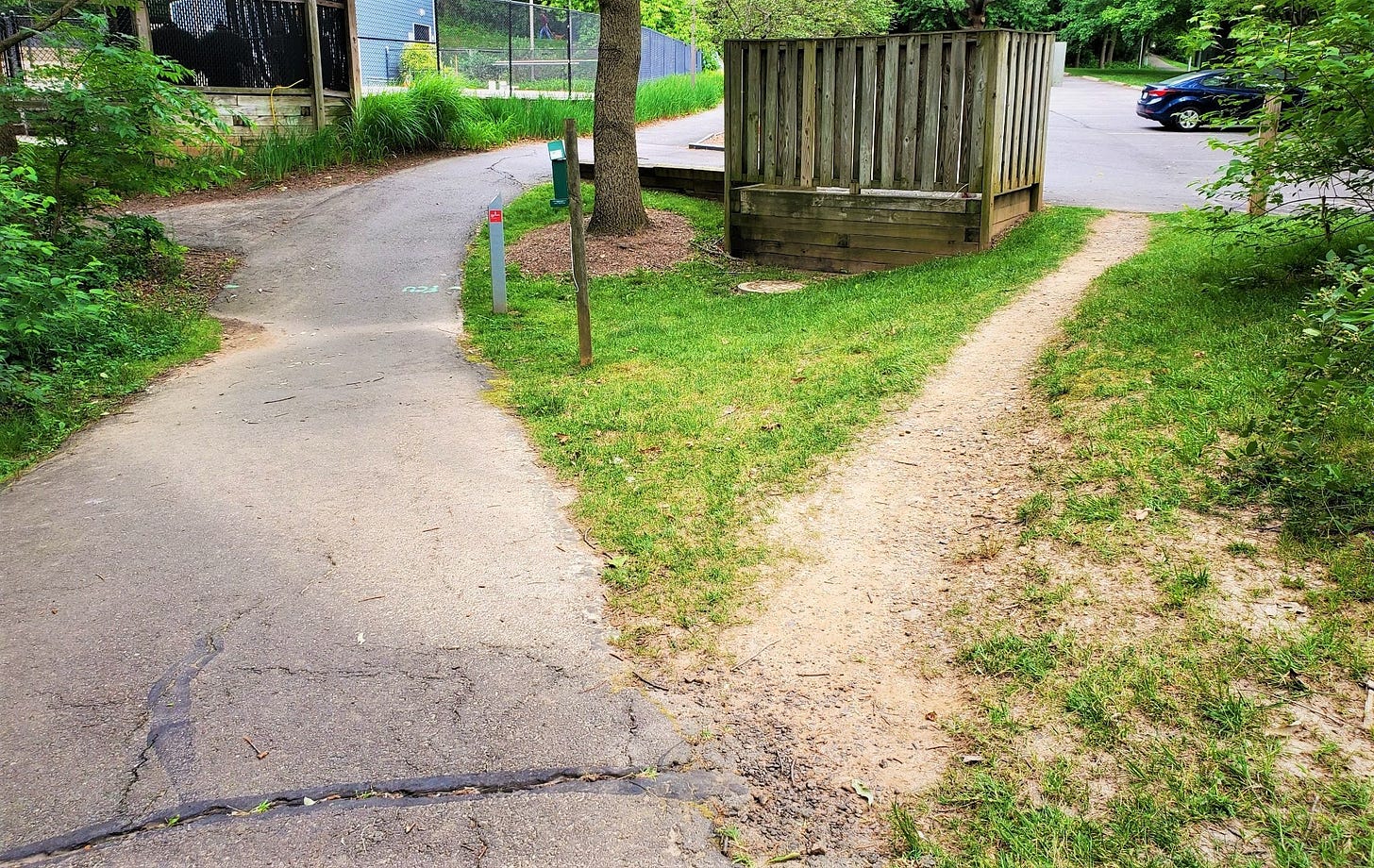If you follow urbanist discussion, you’ve likely heard of “desire paths.” But maybe not. This piece is for you.
“Desire paths” are actually one of the more interesting urbanist ideas I’ve come across. This isn’t some policy wonkery. It’s pretty simple: a “desire path” is an informal path people take, as opposed to the official path, in a property or along a road. It’s usually a shortcut, and it’s generally through grass or landscaping. Trails cutting corners across a college quad? Narrow lines in the grass along roads without sidewalks? Those are desire paths.
Here’s one by some medical offices in my home of Reston, Virginia:
Here’s another at a park/fishing pier area:
This is one of those familiar things you don’t really think about. But once you put a name to it and keep your eyes open, you notice it everywhere. This is one the ways in which urbanism has helped me see places more fully, in more detail and with new eyes.
Generally, urbanists see this as voting with your feet. Desire paths reveal where people are actually walking, and how they inhabit space, apart from how planners or landscapers want them to. In other words, they’re information; information that really should have been gathered ahead of time and been part of the initial design.
Now I can see some conservatives looking askance at this: “What’s next, ‘listening’ to turnstile jumpers and getting rid of subway fares?” (Yes, some transit advocates want free public transit, but at least as many don’t. That, however, is a different issue.) I can see a reticence to “reward” people for “breaking the rules.” But that’s overthinking it. Consider a package that’s almost impossible to open. Consider an app or software program with an incomprehensible interface. Sidewalks or paths in areas where walking doesn’t actually feel comfortable or convenient are kind of the same thing. It’s a user design issue. And generally, the user, like customer, is right. Think of desire paths not as rule-breaking but as crowdsourcing information about how people organically use public space.
And sometimes, that actually happens. Here’s a housing development where what was obviously an informal path has actually been mulched over; whoever determines landscaping for the property decided to just accept the user input make it a “real” path!
I have one more really neat example of this: the paved walking paths on the University of Maryland mall or main quad were paved and written into the mall design after a period of having only grass. The designers allowed students to walk wherever they wanted and then placed the paths where the students had already made them! Here’s an old picture I have of the mall:
A college-oriented website relays the story:
Rather than cutting across the mall in straight, parallel lines, the sidewalks crisscross the grass. Student Coordinator Sapna Khemka explained, “The president of the university decided to let the students decide where they needed sidewalks. There were no paths, so students just walked across the grass. Then the president had sidewalks built wherever the grass was most trampled down.”
I earned my master’s degree at University of Maryland, and while I didn’t know this story until after I graduated, I always appreciated the large number of paths on the mall. I’m not sure I ever strayed from the paths to make my own desire path—which reflects the good design. If a critical mass of people are using your design “wrong,” maybe you’ve made a mistake. Paving desire paths is a little show of humility, in a way.
There’s a whole “subreddit” on desire paths, if Reddit is your thing. Here’s a good piece on the phenomenon, which dubs it “pedestrian democracy.” And here’s a long piece full of interesting links and sources, which suggests desire paths resemble civil disobedience and characterizes them as “defying the urban planners.”
But while you can half-seriously imagine all kinds of ideological and political aspects to this, it’s also, like so much of urbanism, very practical and commonsense. Some people like to walk. Some people have to. It shouldn’t be hard.
Related Reading:
Speeding and the Eucharistic Prayer
Kinney Shoes’ Architectural Afterlife
If you like what you’re seeing, please consider a paid subscription to help support this work. You’ll get a weekend subscribers-only post, plus full access to the archive. And you’ll help ensure more material like this!








James Scott has a lovely little essay on this in Two Cheers for Anarchism as well! Good stuff.